Abstract
Objectives
The aim of this study was to compare the push-out bond strength (POBS) of three calcium silicate–based cements (CSBC) after exposure to saline, sodium hypochlorite (NaOCl), ethylenediaminetetraacetic acid (EDTA), and a mixture of NaOCl and etidronic acid (NaOCl+HEBP) in simulated perforation.
Materials and methods
A total of 180 dentin slices were perforated and then filled with either Biodentine (BD), ProRoot MTA (PMTA), or Total Fill (TF). After 1 week, specimens in each group were divided into 4 subgroups (n = 15) according to the root canal irrigant (RCI) that their coronal surface was exposed to: saline, 5.25% NaOCl, 17% EDTA, or a mixture of 5.25% NaOCl and 9% HEBP (NaOCl+HEBP). A push-out test was performed, and the failure pattern was assessed. POBS data were analyzed with ANOVA and Tukey post hoc tests and the failure patterns with chi-square test.
Results
No differences were found when comparing the effect of RCI on the POBS of PMTA. BD showed significantly higher POBS values after exposure to NaOCl+HEBP (p < .05), and those of TF were significantly lower after exposure to EDTA (p < .05). No differences in the failure patterns were found among groups.
Conclusion
NaOCl+HEBP had no detrimental effect on the POBS of CSBC.
Clinical relevance
The mixture of sodium hypochlorite and etidronic acid may be considered as an alternative irrigant when treating root perforations.



Similar content being viewed by others
References
Sinai IH (1977) Endodontic perforations: their prognosis and treatment. J Am Dent Assoc 95(1):90–95. https://doi.org/10.14219/jada.archive.1977.0531
Kvinnsland I, Oswald RJ, Halse A, Grønningsaeter AG (1989) A clinical and roentgenological study of 55 cases of root perforation. Int Endod J 22(2):75–84. https://doi.org/10.1111/j.1365-2591.1989.tb00509.x
Saed SM, Ashley MP, Darcey J (2016) Root perforations: aetiology, management strategies and outcomes. The hole truth. Br Dent J 220(4):171–180. https://doi.org/10.1038/sj.bdj.2016.132
Guneser MB, Akbulut MB, Eldeniz AU (2013) Effect of various endodontic irrigants on the push-out bond strength of Biodentine and conventional root perforation repair materials. J Endod 39(3):380–384. https://doi.org/10.1016/j.joen.2012.11.033
Uyanik MO, Nagas E, Sahin C, Dagli F, Cehreli ZC (2009) Effects of different irrigation regimens on the sealing properties of repaired furcal perforations. Oral Surg Oral Med Oral Pathol Oral Radiol Endod 107(3):e91–e95. https://doi.org/10.1016/j.tripleo.2008.10.024
Alsubait SA (2017) Effect of sodium hypochlorite on push-out bond strength of four calcium silicate-based endodontic materials when used for repairing perforations on human dentin: an in vitro evaluation. J Contemp Dent Pract 18(4):289–294. https://doi.org/10.5005/jp-journals-10024-2033
Nagas E, Kucukkaya S, Eymirli A, Uyanik MO, Cehreli ZC (2017) Effect of laser-activated irrigation on the push-out bond strength of Proroot mineral trioxide aggregate and Biodentine in furcal perforations. Photomed Laser Surg 35(4):231–235. https://doi.org/10.1089/pho.2016.4171
Prasanthi P, Garlapati R, Nagesh B, Sujana V, Kiran Naik KM, Yamini B (2019) Effect of 17% ethylenediaminetetraacetic acid and 0.2% chitosan on pushout bond strength of Biodentine and ProRoot mineral trioxide aggregate: an in vitro study. J Conserv Dent 22(4):387–390. https://doi.org/10.4103/jcd.Jcd_56_19
Elnaghy AM (2014) Influence of QMix irrigant on the micropush-out bond strength of Biodentine and white mineral trioxide aggregate. J Adhes Dent 16(3):277–283. https://doi.org/10.3290/j.jad.a32072
Ulusoy ÖI, Paltun YN, Güven N, Çelik B (2016) Dislodgement resistance of calcium silicate-based materials from root canals with varying thickness of dentine. Int Endod J 49(12):1188–1193. https://doi.org/10.1111/iej.12573
Parirokh M, Torabinejad M, Dummer PMH (2018) Mineral trioxide aggregate and other bioactive endodontic cements: an updated overview - part I: vital pulp therapy. Int Endod J 51(2):177–205. https://doi.org/10.1111/iej.12841
Torabinejad M, Parirokh M, Dummer PMH (2018) Mineral trioxide aggregate and other bioactive endodontic cements: an updated overview - part II: other clinical applications and complications. Int Endod J 51(3):284–317. https://doi.org/10.1111/iej.12843
Zamparini F, Siboni F, Prati C, Taddei P, Gandolfi MG (2019) Properties of calcium silicate-monobasic calcium phosphate materials for endodontics containing tantalum pentoxide and zirconium oxide. Clin Oral Investig 23(1):445–457. https://doi.org/10.1007/s00784-018-2453-7
do Prado M, de Lima CO, Marques JD, Ballal V, Simao RA, Campos CN (2019) Effect of different irrigation regimens on the bond strength of Biodentine used for furcal perforation repair. ENDO-Endod Pract Today 13(1):49–59
Guo YJ, Du TF, Li HB, Shen Y, Mobuchon C, Hieawy A, Wang ZJ, Yang Y, Ma J, Haapasalo M (2016) Physical properties and hydration behavior of a fast-setting bioceramic endodontic material. BMC Oral Health 16:23. https://doi.org/10.1186/s12903-016-0184-1
Total Fill BCRRM safety data sheet and instructions for use. https://www.fkg.ch/products/endodontics/obturation/totalfill.
Biodentine safety data sheet and package insert. https://www.septodontusa.com/products/biodentine.
ProRoot MTA safety data sheet and directions for use https://www.dentsplysirona.com/en-ca/products/endodontics/obturation.html/Endodontics/Obturation/Cements/ProRoot-MTA-Root-Repair-Material/p/TUL-PRCEMW/c/1000145.html.
Camilleri J, Sorrentino F, Damidot D (2013) Investigation of the hydration and bioactivity of radiopacified tricalcium silicate cement, Biodentine and MTA Angelus. Dent Mater 29(5):580–593. https://doi.org/10.1016/j.dental.2013.03.007
Paulson L, Ballal NV, Bhagat A (2018) Effect of root dentin conditioning on the pushout bond strength of Biodentine. J Endod 44(7):1186–1190. https://doi.org/10.1016/j.joen.2018.04.009
Ballal V, Marques JN, Campos CN, Lima CO, Simão RA, Prado M (2018) Effects of chelating agent and acids on Biodentine. Aust Dent J 63(2):170–176. https://doi.org/10.1111/adj.12609
Zehnder M (2006) Root canal irrigants. J Endod 32(5):389–398. https://doi.org/10.1016/j.joen.2005.09.014
Neelakantan P, Nandagopal M, Shemesh H, Wesselink P (2015) The effect of root dentin conditioning protocols on the push-out bond strength of three calcium silicate sealers. Int J Adhes Adhes 60:104–108. https://doi.org/10.1016/j.ijadhadh.2015.04.006
Ballal NV, Ulusoy Ö, Chhaparwal S, Ginjupalli K (2018) Effect of novel chelating agents on the push-out bond strength of calcium silicate cements to the simulated root-end cavities. Microsc Res Tech 81(2):214–219. https://doi.org/10.1002/jemt.22969
Govindaraju L, Neelakantan P, Gutmann JL (2017) Effect of root canal irrigating solutions on the compressive strength of tricalcium silicate cements. Clin Oral Investig 21(2):567–571. https://doi.org/10.1007/s00784-016-1922-0
Elnaghy AM (2014) Influence of acidic environment on properties of biodentine and white mineral trioxide aggregate: a comparative study. J Endod 40(7):953–957. https://doi.org/10.1016/j.joen.2013.11.007
Mohebbi P, Asgary S (2016) Effect of pH on physical properties of two endodontic biomaterials. J Conserv Dent 19(3):212–219. https://doi.org/10.4103/0972-0707.181935
Shokouhinejad N, Yazdi KA, Nekoofar MH, Matmir S, Khoshkhounejad M (2014) Effect of acidic environment on dislocation resistance of endosequence root repair material and mineral trioxide aggregate. J Dent (Tehran) 11(2):161–166
Shokouhinejad N, Nekoofar MH, Iravani A, Kharrazifard MJ, Dummer PM (2010) Effect of acidic environment on the push-out bond strength of mineral trioxide aggregate. J Endod 36(5):871–874. https://doi.org/10.1016/j.joen.2009.12.025
Saghiri MA, Shokouhinejad N, Lotfi M, Aminsobhani M, Saghiri AM (2010) Push-out bond strength of mineral trioxide aggregate in the presence of alkaline pH. J Endod 36(11):1856–1859. https://doi.org/10.1016/j.joen.2010.08.022
Marquezan FK, Kopper PMP, Dullius A, Ardenghi DM, Grazziotin-Soares R (2018) Effect of blood contamination on the push-out bond strength of calcium silicate cements. Braz Dent J 29(2):189–194. https://doi.org/10.1590/0103-6440201801766
Alamoudi RA, Abu Zeid ST (2019) Effect of irrigants on the push-out bond strength of two bioceramic root repair materials. Materials (Basel) 12(12). https://doi.org/10.3390/ma12121921
Yan P, Peng B, Fan B, Fan M, Bian Z (2006) The effects of sodium hypochlorite (5.25%), Chlorhexidine (2%), and Glyde File Prep on the bond strength of MTA-dentin. J Endod 32(1):58–60. https://doi.org/10.1016/j.joen.2005.10.016
Gancedo-Caravia L, Garcia-Barbero E (2006) Influence of humidity and setting time on the push-out strength of mineral trioxide aggregate obturations. J Endod 32(9):894–896. https://doi.org/10.1016/j.joen.2006.03.004
Ballal NV, Sona M, Tay FR (2017) Effects of smear layer removal agents on the physical properties and microstructure of mineral trioxide aggregate cement. J Dent 66:32–36. https://doi.org/10.1016/j.jdent.2017.08.018
Neelakantan P, Berger T, Primus C, Shemesh H, Wesselink PR (2019) Acidic and alkaline chemicals’ influence on a tricalcium silicate-based dental biomaterial. J Biomed Mater Res B Appl Biomater 107(2):377–387. https://doi.org/10.1002/jbm.b.34129
Lee YL, Lin FH, Wang WH, Ritchie HH, Lan WH, Lin CP (2007) Effects of EDTA on the hydration mechanism of mineral trioxide aggregate. J Dent Res 86(6):534–538. https://doi.org/10.1177/154405910708600609
Grech L, Mallia B, Camilleri J (2013) Investigation of the physical properties of tricalcium silicate cement-based root-end filling materials. Dent Mater 29(2):e20–e28. https://doi.org/10.1016/j.dental.2012.11.007
Wang X, Sun H, Chang J (2008) Characterization of Ca3SiO5/CaCl2 composite cement for dental application. Dent Mater 24(1):74–82. https://doi.org/10.1016/j.dental.2007.02.006
Collares FM, Portella FF, Rodrigues SB, Celeste RK, Leitune VCB, Samuel SMW (2016) The influence of methodological variables on the push-out resistance to dislodgement of root filling materials: a meta-regression analysis. Int Endod J 49(9):836–849. https://doi.org/10.1111/iej.12539
Marcaccini AM, Pavanelo A, Nogueira AV, Souza JA, Porciúncula HF, Cirelli JA (2012) Morphometric study of the root anatomy in furcation area of mandibular first molars. J Appl Oral Sci 20(1):76–81. https://doi.org/10.1590/s1678-77572012000100014
Scelza MZ, da Silva D, Scelza P, de Noronha F, Barbosa IB, Souza E, De Deus G (2015) Influence of a new push-out test method on the bond strength of three resin-based sealers. Int Endod J 48(8):801–806. https://doi.org/10.1111/iej.12378
Carvalho NK, Prado MC, Senna PM, Neves AA, Souza EM, Fidel SR, Sassone LM, Silva E (2017) Do smear-layer removal agents affect the push-out bond strength of calcium silicate-based endodontic sealers? Int Endod J 50(6):612–619. https://doi.org/10.1111/iej.12662
Author information
Authors and Affiliations
Corresponding author
Ethics declarations
Conflict of interest
The authors declare that they have no conflict of interest.
Ethical approval
This study was conducted with the approval of the Ethics Committee of Clinical Research of San Carlos Hospital (Madrid) (C.I. 16/355-E).
Additional information
Publisher’s note
Springer Nature remains neutral with regard to jurisdictional claims in published maps and institutional affiliations.
Rights and permissions
About this article
Cite this article
Rebolloso de Barrio, E., Gancedo-Caravia, L., García-Barbero, E. et al. Effect of exposure to root canal irrigants on the push-out bond strength of calcium silicate–based cements. Clin Oral Invest 25, 3267–3274 (2021). https://doi.org/10.1007/s00784-020-03658-x
Received:
Accepted:
Published:
Issue Date:
DOI: https://doi.org/10.1007/s00784-020-03658-x




